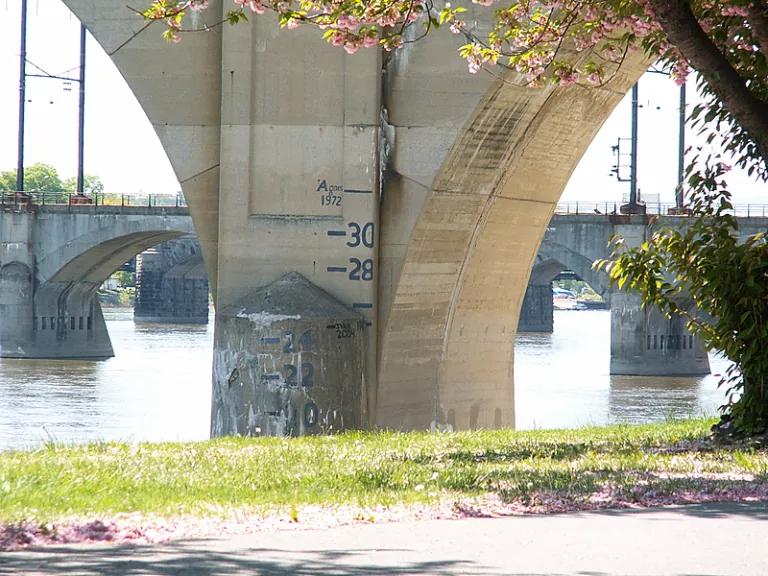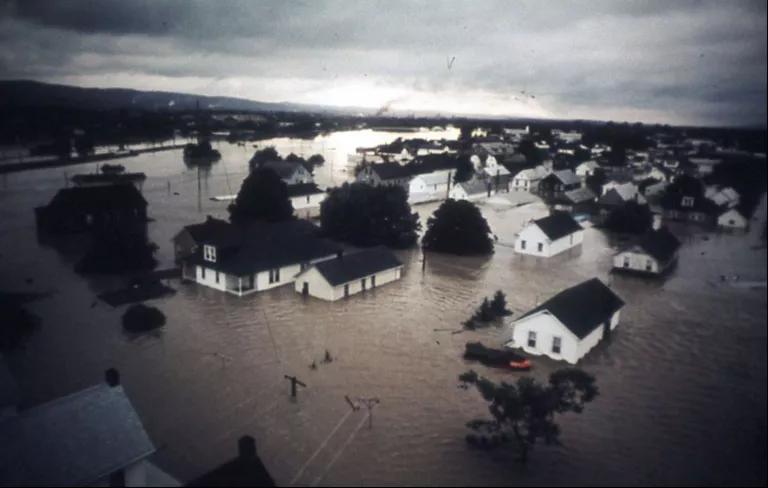50 Years After Hurricane Agnes: What Have We Learned?
Hurricane Agnes left a lasting legacy on flood protection and disaster policy. Let’s take a closer look at what’s changed—and what hasn’t.

The Chemung River (a tributary of the Susquehanna) inundates downtown Elmira, NY, during Hurricane Agnes in June 1972.
Hurricane Agnes—which caused devastating floods across the Mid-Atlantic states 50 years ago this week—still stands as the “flood of record” for many communities. The storm killed 128 people and was, at the time, the costliest hurricane in U.S. history.
Agnes was the first named storm of the 1972 Atlantic hurricane season. It first made landfall in western Florida on June 19 but moved out to sea over the Carolinas a few days later. Agnes then made a second landfall on Long Island on June 22 as it poured massive amounts of rain over New York and Pennsylvania. The extremely heavy rainfall (over 15 inches in some places) on already-saturated ground led to downstream rivers and streams rising at unprecedented rates. Hundreds of thousands of people were evacuated as water levels approached and, in some cases, overtopped dams and levees.
The more things change, the more things stay the same
When I was growing up in south-central Pennsylvania, people from my parents’ and grandparents’ generations talked about Agnes as “the big one.” Walks along the waterfront in nearby Harrisburg often included stopping under the bridges to look at high-water marks painted far above our heads. When it comes to flood protection and risk mitigation, a lot of things have changed in the past 50 years, some as a direct result of Agnes. But a surprising number of programs and policies have barely progressed. Let’s take a closer look at what’s changed—and what hasn’t.

A painted high-water mark on a local bridge illustrates the Susquehanna River’s record 33 ft crest during Hurricane Agnes in Harrisburg, PA. Flood stage here is 17 ft.
Flood insurance
In 1972, the National Flood Insurance Program (then administered by HUD, the Department of Housing and Urban Development) was less than five years old. Fewer than 1,200 communities even participated in the NFIP and less than 1% of the insurable damage from Agnes was covered. In Wilkes-Barre, PA, perhaps the city hardest hit by the floods, only two flood insurance policies had been sold so far. Later in 1972, NFIP premiums were actually lowered to encourage participation in the program.
The following year, Congress passed the Flood Disaster Protection Act of 1973, which required property owners in the Special Flood Hazard Area to carry flood insurance as a condition of receiving federal disaster aid along, with several other provisions that are still components of the NFIP. In the early 1970s, the first floodplain management regulations were put in place, setting the minimum standards for NFIP participation.
While the NFIP has seen some additional changes over the years, those 1970s floodplain management standards are still in place. Just this year, thanks to a legal petition by NRDC and our partners at the Association of State Floodplain Managers, FEMA finally began the process to revise the regulations and make the necessary changes to protect communities from flooding in our climate-changed world.
Nonstructural flood protection
Prior to Agnes, most flood protection activities focused on “structural” measures: physical barriers like levees, dikes, and dams. While some structural features still worked as designed even in the face of Agnes’ inundation (including the famous “We Love You, Wall” floodwall in Sunbury, PA), the storm illustrated the limits of relying only on engineered protections. The text of Pennsylvania’s 1978 Flood Plain Management Act, created in response to Agnes, notes specifically that “the exclusive use of flood control measures, such as engineering projects, has failed to significantly reduce the human suffering and economic losses caused by recurrent flooding.”
Over the next few decades, flood risk mitigation began to feature more “non-structural” actions, like floodplain restoration, buying out flood-prone properties and preserving the land as open space, and improving flood mapping, warning systems, and other ways of sharing risk information. Agencies like FEMA and the Army Corps of Engineers are increasingly promoting natural and nature-based solutions to flooding through their programs. However, billions of dollars in federal spending still goes to environmentally and socially damaging structural projects. Agencies should continue increasing support for nature-based solutions (as well as other community-driven efforts that prioritize people over property) through programs like FEMA’s BRIC grants.
Due to climate change, hurricanes are more likely to be like Agnes: very, very wet with the primary danger coming from water rather than wind. Agnes’ winds never exceeded Category 1 levels and, in fact, it caused its most devastating effects while classified “only” as a tropical storm. (Some of the most deadly and destructive recent hurricanes, like Sandy, Harvey, and Florence, have followed this pattern, with the worst impacts coming from inland precipitation and storm surge.) Compared to structural measures, which are difficult and costly to retrofit, natural and nature-based solutions are more flexible in the face of changing conditions, while providing multiple benefits to communities.

Homes in Wilkes-Barre, PA, are flooded with several feet of water in the aftermath of Agnes.
Federal disaster management
One of Agnes’ biggest legacies might be the creation of the Federal Emergency Management Agency. Through the first half of the 20th century, the U.S. federal government had its disaster-related authorities scattered among a wide variety of federal agencies and offices. After the storm, then-HUD Secretary George Romney recommended the following to President Nixon:
The magnitude of this disaster has strained the response capabilities of all federal and nonprofit agencies. I recommend that our national preparedness programs be examined, revamped and strengthened as necessary to assure that an adequate state of readiness is established and maintained for such major catastrophes. This should include preventative measures as well as action plans for an immediate and effective response on the part of all Federal agencies when a disaster occurs.
In 1973, the Nixon administration consolidated several federal disaster relief and recovery programs into the new Federal Disaster Assistance Administration within HUD. A few years later, in 1979, President Carter signed an executive order creating an independent Federal Emergency Management Agency. (FEMA became part of the Department of Homeland Security in 2003.)
While FEMA took on many aspects of disaster mitigation, preparation, response, and recovery, there is still no federal entity that can objectively and independently review the nation’s responses to disasters. New legislation in Congress would finally address this gap, creating a National Disaster Safety Board to help the nation apply all of the lessons we have learned since Agnes—and beyond. This is particularly important as policymakers pay increasing attention the long-standing inequities inherent in (and often caused by) federal disaster policies.
Toward the next 50 years
Today, Agnes’ multi-billion-dollar price tag (adjusted for inflation) would be much less groundbreaking, with billion-dollar disasters happening every 18 days on average. However, the storm’s legacy remains in many of the ways that we address—or fail to address—flooding and disaster risk. How has flooding changed in your area in the past 50 years? What would you most like to see as we move forward? The solutions may look different in different communities, but one thing is clear: the nation’s policies must continue to evolve to reflect the realities of climate change and protect those in harm’s way.
We can’t afford look back in another 50 years and say, “So many things haven’t changed.” Instead, we need to work now to build a climate-smart National Flood Insurance Program, enable faster and more equitable buyout programs, adopt nation-wide flood protection standards, establish a National Disaster Safety Board, and ensure equity and climate are included in decision-making across levels of government. It’s time to learn from the past and apply those lessons to the future.
To learn more about Hurricane Agnes, check out this interactive map from the interagency Silver Jackets initiative: https://agnes50-noaa.hub.arcgis.com/.



